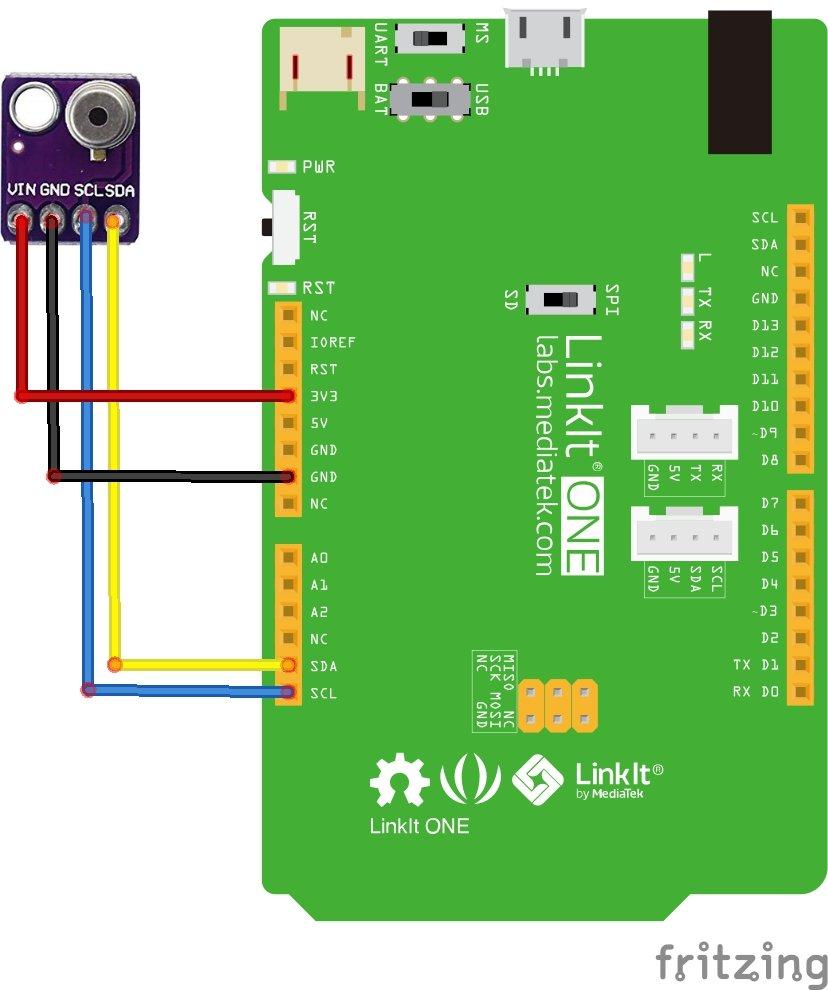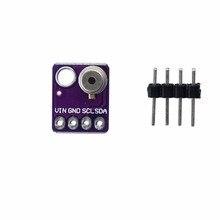In this example we take a look at an MLX90615 IR thermometer, we will connect this to a LinkIT one. There will be 2 examples to look at which are written using the Arduino IDE
The MLX90615 is a miniature infrared thermometer for non-contact temperature measurements. Both the IR sensitive thermopile detector chip and the signal conditioning ASIC are integrated in the same miniature TO-46 can.
The infrared thermometer comes factory calibrated with a digital SMBus output giving full access to the measured temperature in the complete temperature range(s) with a resolution of 0.02 °C. The sensor achieves an accuracy of ±0.2°C within the relevant medical temperature range. The user can choose to configure the digital output to be PWM.
Features and benefits
Factory calibrated in wide temperature range: -20 to 85°C for sensor temperature and -40 to 115°C for object temperature
High accuracy of 0.5°C over wide temperature range (0..+50 C for both Ta and To)
Medical accuracy of 0.2°C in a limited temperature range
Measurement resolution of 0.02°C
SMBus compatible digital interface for fast temperature readings and building sensor networks
Customizable PWM output for continuous reading
3V supply voltage with power saving mode
Parts List
| Amount | Part Type |
|---|---|
| 1 | MLX90615 Digital Infrared Temperature Sensor for Arduino GY Series Module |
| 1 | LinkIt ONE MT2502A wireless 2503 development board |
Connection
An easy device to connect, simple I2C sensor that requires 3.3v and GND.

Test Code
This particular example comes from the following library which I installed – https://github.com/skiselev/MLX90615
[codesyntax lang=”cpp”]
#include <Wire.h>
#include <mlx90615.h>
MLX90615 mlx = MLX90615();
void setup()
{
Serial.begin(9600);
Serial.println("Melexis MLX90615 infra-red temperature sensor test");
mlx.begin();
Serial.print("Sensor ID number = ");
Serial.println(mlx.get_id(), HEX);
}
void loop()
{
Serial.print("Ambient = ");
Serial.print(mlx.get_ambient_temp());
Serial.print(" *C\tObject = ");
Serial.print(mlx.get_object_temp());
Serial.println(" *C");
delay(500);
}
[/codesyntax]
Test Output
In the serial monitor and you should see something like this. The warmer object reading was when I placed my finger near the sensor
Ambient = 24.31 *C Object = 33.23 *C
Ambient = 24.23 *C Object = 31.63 *C
Ambient = 24.19 *C Object = 32.25 *C
Ambient = 24.23 *C Object = 37.57 *C
Ambient = 24.27 *C Object = 38.31 *C
Ambient = 24.37 *C Object = 37.11 *C
Ambient = 24.41 *C Object = 36.87 *C
Ambient = 24.45 *C Object = 35.99 *C
Ambient = 24.49 *C Object = 35.47 *C
Ambient = 24.49 *C Object = 33.81 *C
Web page Example
There are 3 lines that will/may need changed for your Wifi details
#define WIFI_AP "wifi ssid here" #define WIFI_PASSWORD "password here" #define WIFI_AUTH LWIFI_WPA The last one you can select from from LWIFI_OPEN, LWIFI_WPA, or LWIFI_WEP according to your WiFi AP configuration
Now for the complete code example
[codesyntax lang=”cpp”]
#include <LTask.h>
#include <LWiFi.h>
#include <LWiFiServer.h>
#include <LWiFiClient.h>
#include <mlx90615.h>
#define WIFI_AP "iainhendry"
#define WIFI_PASSWORD "iain061271"
#define WIFI_AUTH LWIFI_WPA
MLX90615 mlx = MLX90615();
LWiFiServer server(80);
void setup()
{
LTask.begin();
LWiFi.begin();
Serial.begin(9600);
//output MLX90615 info via serial
Serial.println("Melexis MLX90615 infra-red temperature sensor test");
mlx.begin();
Serial.print("Sensor ID number = ");
Serial.println(mlx.get_id(), HEX);
// keep retrying until connected to AP
Serial.println("Connecting to AP");
while (0 == LWiFi.connect(WIFI_AP, LWiFiLoginInfo(WIFI_AUTH, WIFI_PASSWORD)))
{
delay(1000);
}
//connect and display IP address
printWifiStatus();
Serial.println("Start Server");
server.begin();
Serial.println("Server Started");
}
int loopCount = 0;
void loop()
{
// put your main code here, to run repeatedly:
delay(500);
loopCount++;
LWiFiClient client = server.available();
if (client)
{
Serial.println("new client");
// an http request ends with a blank line
boolean currentLineIsBlank = true;
unsigned long timer_out = millis();
while (client.connected())
{
if(millis()-timer_out > 5000)break;
if (client.available())
{
// we basically ignores client request, but wait for HTTP request end
int c = client.read();
Serial.print((char)c);
if (c == '\n' && currentLineIsBlank)
{
Serial.println("send response");
// send a standard http response header
client.println("HTTP/1.1 200 OK");
client.println("Content-Type: text/html");
client.println("Connection: close"); // the connection will be closed after completion of the response
client.println("Refresh: 5"); // refresh the page automatically every 5 sec
client.println();
client.println("<!DOCTYPE HTML>");
client.println("<html>");
// output the value of each analog input pin
client.print("Ambient = ");
client.print(mlx.get_ambient_temp());
client.print(" *C\tObject = ");
client.print(mlx.get_object_temp());
client.println(" *C");
break;
}
if (c == '\n')
{
// you're starting a new line
currentLineIsBlank = true;
}
else if (c != '\r')
{
// you've gotten a character on the current line
currentLineIsBlank = false;
}
}
}
// give the web browser time to receive the data
delay(500);
// close the connection:
Serial.println("close connection");
client.stop();
Serial.println("client disconnected");
}
}
void printWifiStatus()
{
// print the SSID of the network you're attached to:
Serial.print("SSID: ");
Serial.println(LWiFi.SSID());
// print your WiFi shield's IP address:
IPAddress ip = LWiFi.localIP();
Serial.println("Please open your browser, and input the following address:");
Serial.println(ip);
Serial.print("\r\nsubnet mask: ");
Serial.println(LWiFi.subnetMask());
Serial.print("gateway IP: ");
Serial.println(LWiFi.gatewayIP());
// print the received signal strength:
long rssi = LWiFi.RSSI();
Serial.print("signal strength (RSSI):");
Serial.print(rssi);
Serial.println(" dBm");
}
[/codesyntax]
This example has test code to help you out – the printWifiStatus function, open up the USB Modem Port – not the programming port. You should see a message like this
Connecting to AP
SSID: your ssid here
Please open your browser, and input the following address:
192.168.1.15
Web page Output
Open up your favourite web browser and you should see a line that updates every 5 seconds
Ambient = 23.09 *C Object = 24.23 *C
Links
https://www.melexis.com/-/media/files/documents/datasheets/mlx90615-datasheet-melexis.pdf


